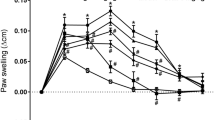Abstract
In vivo experiments were designed to verify the analgesic effect of Dragon’s Blood and the material basis for this effect. Extracellular microelectrode recordings were used to observe the effects of Dragon’s Blood and various combinations of the three components (cochinchinenin A, cochinchinenin B, and loureirin B) extracted from Dragon’s Blood on the discharge activities of wide dynamic range (WDR) neurons in spinal dorsal horn (SDH) of intact male Wistar rats evoked by electric stimulation at sciatic nerve. When the Hill’s coefficients describing the dose-response relations of drugs were different, based on the concept of dose equivalence, the equations of additivity surfaces which can be applied to assess the interaction between three drugs were derived. Adopting the equations and Tallarida’s isobole equations used to assess the interaction between two drugs with dissimilar dose-response relations, the effects produced by various combinations of the three components in modulating the evoked discharge activities of WDR neurons were evaluated. Results showed that Dragon’s Blood and its three components could inhibit the evoked discharge frequencies of WDR neurons in a concentration-dependent way. The Hill’s coefficients describing dose-response relations of three components were different. Only the combined effect of cochinchinenin A, cochinchinenin B and loureirin B was similar to that of Dragons Blood. Furthermore, the combined effect was synergistic. This investigation demonstrated that through the synergistic interaction of the three components Dragon’s Blood could interfere with the transmission and processing of pain signals in spinal dorsal horn. All these further proved that the combination of cochinchinenin A, cochinchinenin B, and loureirin B was the material basis for the analgesic effect of Dragon’s Blood.
Similar content being viewed by others
References
Zhao Y, Wang S G, Guo S M, et al. Study about the long-term toxic effects of Dragon’s Blood capsules on rats. Yunnan Journal of Traditional Chinese Medicine and Materia Medica, 2007, 28(4): 33–35
Cao G G, Zhang J Z, Hu Y Q, et al. Comparison on the effects of Dragon’s Blood extracts from thermal independence technology and tradition method. Tianjin Pharmacy, 2005, 17(3): 3–4
Liu X M, Chen S, Yin S J, et al. Effects of Dragon’s Blood and its component loureirin B on tetrodotoxin-sensitive voltage-gated sodium currents in rat dorsal root ganglion neurons. Sci China Ser C-Life Sci, 2004, 47(4): 340–348, 10.1360/03yc0146, 1:CAS:528:DC%2BD2cXovFOksr0%3D
Liu X M, Chen S, Zhang Y X, et al, Modulation of Dragon’s Blood on tetrodotoxin-resistant sodium currents in dorsal root ganglion neurons and identification of its material basis for efficacy. Sci China Ser C-Life Sci, 2006, 49(3): 274–285, 10.1007/s11427-006-0274-4
Almeida T F, Roizenblatt S, Tufik S. Afferent pain pathways: a neuroanatomical review. Brain Res, 2004, 1000: 40–56, 15053950, 10.1016/j.brainres.2003.10.073, 1:CAS:528:DC%2BD2cXisF2htro%3D
Yu L C, Zheng E M, Lundeberg T. Calcitonin gene-related peptide 8–37 inhibits the evoked discharge frequency of wide dynamic range neurons in dorsal horn of the spinal cord in rats. Regul Pept, 1999, 83(1): 21–24, 10498340, 10.1016/S0167-0115(99)00046-4, 1:CAS:528:DyaK1MXlt1Siu7Y%3D
Liu F Y, Xing G G, Qu X X, et al. Roles of 5-HT receptor subtypes in the inhibitory effects of 5-HT on C-fiber responses of spinal wide dynamic range neurons in rats. J Pharmacol Exp Ther, 2007, 321(3): 1046–1053, 17329553, 10.1124/jpet.106.115204, 1:CAS:528:DC%2BD2sXmsFeqs78%3D
Berenbaum M C. What is synergy? Pharmacol Rev, 1989, 41: 93–141, 2692037, 1:CAS:528:DyaK3cXptFSmsA%3D%3D
Loewe S, Muischnek H. Effect of combinations: mathematical basis of the problem. Arch. Exp. Pathol. Pharmakol, 1926, 114: 313–326, 10.1007/BF01952257, 1:CAS:528:DyaB2sXitFCm
Tallarida R J. An overview of drug combination analysis with isobolograms. Perspect Pharmacol, 2006, 319: 1–7, 1:CAS:528:DC%2BD28XhtVCksL%2FO
Tallarida R J. Interactions between drugs and occupied receptors. Pharmacol Therap, 2007, 113: 197–209, 10.1016/j.pharmthera.2006.08.002, 1:CAS:528:DC%2BD2sXhsFCrsA%3D%3D
Urch C E, Dickenson A H. In vivo single unit extracellular recordings from spinal cord neurons of rats. Brain Res Protoc, 2003, 12(1): 26–34, 10.1016/S1385-299X(03)00068-0, 1:STN:280:DC%2BD3szptVaksQ%3D%3D
Coghill R C, Mayer D J, Price D D. Wide dynamic range but not nociceptive-specific neurons encode multidimensional features of prolonged repetitive heat pain. J Neurophysiol, 1993, 69: 703–716, 8385190, 1:STN:280:ByyB3MjkvFA%3D
Vahle-Hinz C, Detsch O. What can in vivo electrophysiology in animal models tell us about mechanisms of anaesthesia? Brit J Anaesth, 2002, 89(1): 123–142, 12173225, 10.1093/bja/aef166, 1:STN:280:DC%2BD38vhvVyqtA%3D%3D
Melzak R, Wall P D. Pain mechanisms: a new theory. Science, 1965, 150: 971–979, 10.1126/science.150.3699.971
Melzack R. From the gate to the neuromatrix. Pain, 1999, 6: 121–126, 10.1016/S0304-3959(99)00145-1
Nobukuni O, Yoshiaki O. Molecular diversity of structure and function of the voltage-gated Na+ Channels. Jpn J Pharmacol, 2002, 88: 365–377, 10.1254/jjp.88.365
Hains B C, Saab C Y, Waxman S G. Changes in electrophysiological properties and sodium channel Nav1.3 expression in thalamic neurons after spinal cord injury. Brain, 2005, 128(10): 2359–2371, 16109750, 10.1093/brain/awh623
Hains B C, Klein J P, Saab C Y, et al. Upregulation of sodium channel Nav1.3 and functional involvement in neuronal hyperexcitability associated with central neuropathic pain after spinal cord injury. J Neurosci, 2003, 23(26): 8881–8892, 14523090, 1:CAS:528:DC%2BD3sXotFOnur4%3D
Shah B S, Stevens E B, Gonzalez M I, et al. β3, a novel auxiliary subunit for the voltage-gated sodium channel, is expressed preferentially in sensory neurons and is upregulated in the chronic constriction injury model of neuropathic pain. Eur J Neurosci, 2000, 12: 3985–3990, 11069594, 10.1046/j.1460-9568.2000.00294.x, 1:STN:280:DC%2BD3M%2FmtVKmsg%3D%3D
Cummins T R, Aglieco F, Renganathan M. Nav1.3 sodium channels: Rapid repriming and slow closed-state inactivation display quantitative differences after expression in a mammalian cell line and in spinal sensory neurons. J Neurosci, 2001, 21(16): 5952–5956, 11487618, 1:CAS:528:DC%2BD3MXlvFKms7s%3D
Smith C. Drug discovery in reverse. Nature, 2004, 428(6979): 227, 15014516, 10.1038/428225a
Patwardhan B, Vaidya A D B, Chorghade M. Ayurveda and natural products drug discovery. Curr Sci, 2004, 86(6): 789–799
Author information
Authors and Affiliations
Corresponding author
Additional information
Supported by the Nature Science Foundation of State Ethnic Affairs Commission, China (Grant No. MZY06002)
Rights and permissions
About this article
Cite this article
Guo, M., Chen, S. & Liu, X. Material basis for inhibition of Dragon’s Blood on evoked discharges of wide dynamic range neurons in spinal dorsal horn of rats. SCI CHINA SER C 51, 1025–1038 (2008). https://doi.org/10.1007/s11427-008-0133-6
Received:
Accepted:
Published:
Issue Date:
DOI: https://doi.org/10.1007/s11427-008-0133-6




